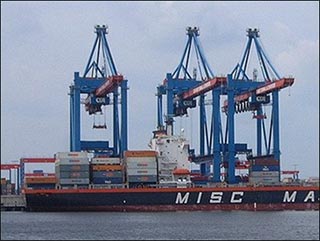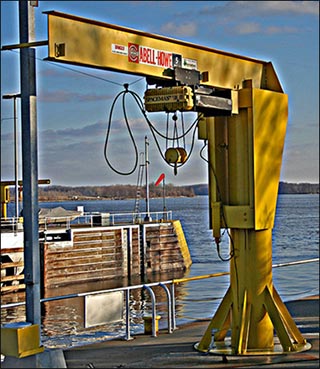Types of Cranes & Girders
Gantry Cranes, Jib Cranes, & Other Configurations
Gantry Cranes, Jib Cranes, & Other Configurations - Types of Girders
Gantry Cranes

Gantry Crane used in shipyard to load and unload ship-borne containers. MV Bunga Raya Satu, Malaysia at the Container Terminal Altenwerder (Hamburg, Germany).
(Photo courtesy of en.wikipedia.org)
Characteristics of Gantry Cranes
- Alternative to Overhead Cranes (same general performance)
- The hoist used for lifting items is fitted into a trolley
- Trolley is mounted on bridge
- Bridge is affixed to supporting uprights
- The uprights may be fixed to the ground or wheeled so that entire mechanism travels on ground-level runway or rails
- Gantries with wheeled uprights are easy to relocate
- Maneuver product in tight spaces or over uneven surfaces
Pros and Cons of Gantry Cranes
- Similar to bridge crane, but less cost
- Spans up to 150 ft
- Capacities up to 150 ton can be used indoor or outdoor
- Simpler installation
- No need for runway structure
Jib Cranes

5-Ton Pedestal Jib Crane used by the US Army Corps of Engineers at the Mississippi Lock and Dam No. 20 in Canton, Missouri. January 13, 2008.
(Photo courtesy of K.Q. Bremmer, Wikipedia.org)
Characteristics of Jib Cranes
- Hoist and Trolley are mounted on a pivoting boom. The pivoting boom (or "arm") is mounted as a cantilever, either on a member of the building
- Wall/column or on a floor-mounted
- Free-standing support
- Wall-mounted boom pivots 180˚
- Floor-mounted booms can pivot 360˚
- Motorized or manual
Jib Crane Uses
- Basic loading/unloading of goods
- Used at individual workstations for:
- Moving machine tools
- Welding
- Fabrication
- Assembly
Pros and Cons of Jib Cranes
- Capacities up to 10-ton
- Lighter loads than bridge or gantry cranes
- Not as precise of control over load as bridge cranes
Jib Crane Variations
- Column-Mounted (or Wall-Mounted) Jib Crane
- Used when floor space is not available for a free-standing support and when there are no overhead obstructions
- Boom pivots 180˚ from a fixed column on the building wall
- Does not require digging a foundation
- Wall-Traveling Jib Crane
- Boom pivots 180˚ from a column on the building wall
- Column travels along the wall on rails
- Can be mounted under a larger overhead bridge crane without interfering with its operation
- Free Standing Jib Crane
- Used when walls or columns are not available
- Requires digging a foundation for support of column; base plate requires floor space
- Boom pivots 360˚ around a floor column
- Can be designed with possible relocation in mind, though new foundation would be needed
- Floor-Mounted Jib Crane
- Requires mounting at top and bottom
- Doesn’t require foundation or base plate
- Boom pivots 360˚ around a floor column
Other configurations
Workstation Bridge Cranes
Workstation crane are typically designed for applications when lifting lighter loads, up to 2-tons. Available as Freestanding or Ceiling Mounted.
Monorails (unlike a bridge crane)
Monorails offer an economical solution for moving and lifting items across a fixed path. The monorail system is permanently attached to the ceiling and enables ease of navigation across short or long distances, including curves or switches with multiple spurs.
Industrial Tripod Cranes
Tripod cranes are an excellent choice for outdoor use and where no overhead support (or ceiling) is available. The tripod is also useful when you need a portable or fast, temporary material lifting solution. Tripods have adjustable, telescoping legs for varying the height for lifting clearance.
Other Types of Jib Cranes:
- Articulating Jib Crane
- Mast Style Jib Crane
- Retrofit Jib Drive